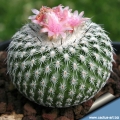




Your support is critical to our success.
Cactaceae Consensus Init. . 5: 12. 1998
Family: CACTACEAE
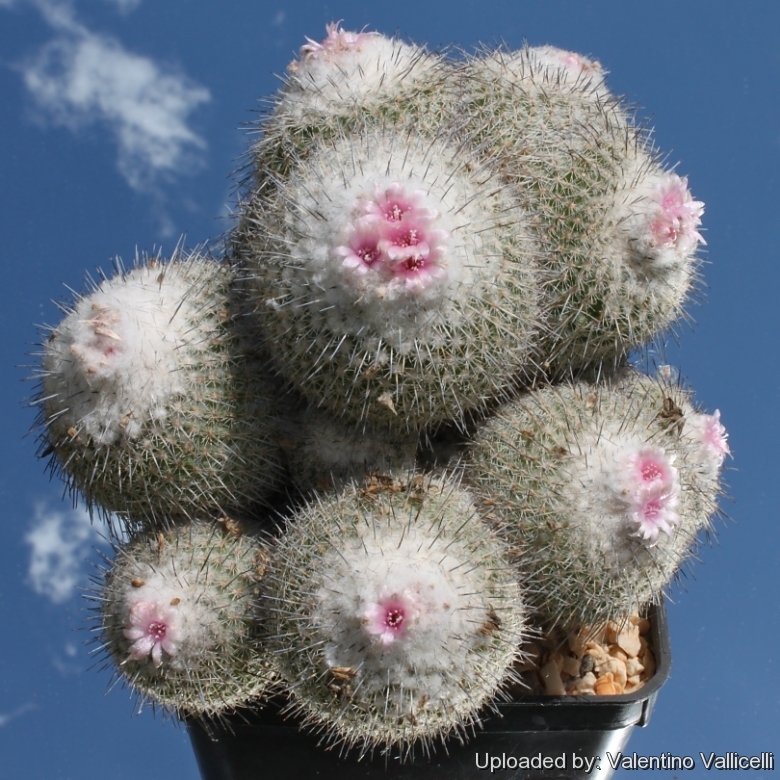
The plant above is a 27 year-old specimen. Ex Prof. Lodi collection (Italy Bologna Botanical Garden )
Origin and Habitat: Monterrey and adjacent areas, Nuevo Leon, North-East Mexico
Altitude: Around 1200 metres above sea level.
Habitat: It grows nested on crevices in step calcareous cliffs together with Mammillaria melanocentraSN|10031]]SN|10031]].
Synonyms:
- Epithelantha micromeris subs. unguispina (Boed.) N.P.Taylor
- Epithelantha micromeris var. unguispina (Boed.) Backeb.
- Epithelantha unguispina (Boed.) D.Donati & Zanov.
- Mammillaria micromeris var. unguispina Boed.
Epithelantha micromeris subs. unguispina (Boed.) N.P.Taylor
Cactaceae Consensus Init. . 5: 12. 1998
Synonymy: 6
- Epithelantha micromeris subs. unguispina (Boed.) N.P.Taylor
- Epithelantha micromeris var. unguispina (Boed.) Backeb.
- Epithelantha unguispina (Boed.) D.Donati & Zanov.
- Mammillaria micromeris var. unguispina Boed.
- Epithelantha spinosior
- Epithelantha unguispina subs. huastecana D.Donati & Zanov.
Epithelantha micromeris (Engelm.) F.A.C.Weber in Bois
Dict. Hort. [Bois] 2: 804. 1898 Britton & Rose, Cactaceae, 3: 93, fig. 102. 1922
Synonymy: 16
- Epithelantha micromeris (Engelm.) F.A.C.Weber in Bois
- Cactus micromeris (Engelm.) Kuntze
- Cephalomamillaria micromeris (Engelm.) Frič
- Echinocactus micromeris (Engelm.) F.A.C.Weber in Bois
- Mammillaria micromeris Engelm.
- Epithelantha micromeris var. caespitosa Y.Itô
- Epithelantha micromeris f. cristata hort.
- Epithelantha micromeris var. longispina Y.Itô
- Epithelantha micromeris var. neomexicana n.n.
- Epithelantha micromeris var. rufispina (Bravo) Backeb.
- Epithelantha greggii var. rufispina (Bravo) Backeb.
- Epithelantha rufispina Bravo
- Epithelantha micromeris var. texensis n.n.
- Epithelantha micromeris var. texensis f. cristata hort.
- Epithelantha micromeris var. typica Croizat
Epithelantha micromeris var. dickisoniae hort.
Synonymy: 3 Accepted name in llifle Database:
Epithelantha micromeris subs. greggii (Engelm.) N.P.Taylor
Cactaceae Consensus Init. 5: 12. 1998
Synonymy: 12
- Epithelantha micromeris subs. greggii (Engelm.) N.P.Taylor
- Cactus micromeris var. greggii (Engelm.) J.M.Coult.
- Cephalomamillaria greggii var. greggii (Engelm.) Frič
- Cephalomamillaria micromeris var. greggii cv. Gray Herb. CardCat., Issue 114 (Engelm.) Frič
- Epithelantha greggii (Engelm.) Orcutt
- Epithelantha micromeris var. greggii (Engelm.) Y.Itô
- Mammillaria greggii (Engelm.) Saff.
- Mammillaria micromeris var. greggii Engelm.
- Epithelantha greggii subs. potosina D.Donati & Zanov.
- Epithelantha micromeris var. densispina (Bravo) Backeb.
- Epithelantha densispina Bravo
- Epithelantha greggii var. densispina (Bravo) Backeb.
Epithelantha micromeris subs. greggii f. cristata
Synonymy: 2 Accepted name in llifle Database:
Epithelantha micromeris subs. pachyrhiza (W.T.Marshall) N.P.Taylor
Cactaceae Consensus Init. 5: 13. 1998
Synonymy: 6
- Epithelantha micromeris subs. pachyrhiza (W.T.Marshall) N.P.Taylor
- Epithelantha micromeris var. pachyrhiza W.T.Marshall
- Epithelantha pachyrhiza (W.T.Marshall) Backeb.
- Epithelantha micromeris f. elongata (Backeb.) Bravo
- Epithelantha pachyrhiza subs. elongata (Backeb.) D.Donati & Zanov.
- Epithelantha pachyrhiza var. elongata Backeb.
Epithelantha micromeris subs. pachyrhiza f. cristata
Accepted name in llifle Database:
Epithelantha micromeris subs. polycephala (Backeb.) Glass
Guía Identif. Cact. Amenazadas México 1: Ep/mi ssp. polycephala (1998 publ. 1997)
Synonymy: 4
- Epithelantha micromeris subs. polycephala (Backeb.) Glass
- Epithelantha greggii subs. polycephala (Backeb.) D.Donati & Zanov.
- Epithelantha micromeris var. polycephala (Backeb.) Glass & R.A.Foster
- Epithelantha polycephala Backeb.
Description: Epithelantha micromeris subs. unguispina (best known under its old name Epithelantha unguispina) is similar to the type species but usually a little larger and free clustering with a distinct, slightly long projecting black-tipped central spines, also the pink flowers are larger than the others.
Habit: It is a miniature globose cactus, erect, clumping over time, not deep-seated in substrate, appearing ashy grey and relatively rough in general aspect.
Stem: Unsegmented, globular, up to 8 cm tall and 6(-7) cm in diameter, often flat-topped with a depressed centre, 3-6 cm in diameter, occasionally more; surface not completely obscured by spines; cortex and pith are not mucilaginous.
Tubercles:** Numerous, not confluent into ribs, hemispheric or short cylindric, very small, ca. 1-3 mm; arranged in tight spirals around the plant.
Areoles: Small at tips of tubercles, 1 mm long, nearly circular, elliptic when distended by flower or fruit, slightly woolly when young, copiously woolly only at sexually mature stem apex; areolar glands absent;
Central spine: One, conspicuously longer than in other subspecies, mostly 4-5mm long (occasianally up to 20 mm), downwards curved and often black-tipped.
Radial spines: (16-)18-22(-24) white to ashy grey white and flattened, somewhat pectinate, appressed on sides of stems, straight, terete, slender, innocuous 1-2,5 mm long.
Roots: Diffuse.
Flower: Small but larger than the others subspecies, pale to deep pink, funnelform diurnal, borne at adaxial margins of spine clusters in the plant top.
Blooming season: Flowers late winter to spring. Autosterile. It is very floriferous.
Fruits: Indehiscent, bright red, thin narrowly cylindric, 3-20 × 2-3(-5) mm, weakly succulent, soon drying and papery, smooth, spineless; pulp absent; floral remnant deciduous.
Remarks:*** Its fruit are known in mexico as "chilitos."
Subspecies, varieties, forms and cultivars of plants belonging to the Epithelantha micromeris group
 Epithelantha micromeris (Engelm.) F.A.C.Weber in Bois: Miniature globose cactus, unbranched or in small clumps. Produces small pink flowers followed by attractive red fruits . Spines are white or greysh, innocuous and appressed on sides of stems.
Epithelantha micromeris (Engelm.) F.A.C.Weber in Bois: Miniature globose cactus, unbranched or in small clumps. Produces small pink flowers followed by attractive red fruits . Spines are white or greysh, innocuous and appressed on sides of stems. Epithelantha micromeris f. cristata hort.: This is a miniature cactus that makes a nice and tangled cluster of fine crests. The stem surface is completely obscured by small pectinated ashy-grey to white spines.
Epithelantha micromeris f. cristata hort.: This is a miniature cactus that makes a nice and tangled cluster of fine crests. The stem surface is completely obscured by small pectinated ashy-grey to white spines. Epithelantha micromeris var. dickisoniae hort.: Minute clustering cactus of doubtful status (but common in cultivation), it shows similarities with Epithelantha micromeris subsp. polycephala and Epithelantha pachyrhiza. Spines are whitish turning to a brownish tinge in adult plant's crown. Roots: Tuberose.
Epithelantha micromeris var. dickisoniae hort.: Minute clustering cactus of doubtful status (but common in cultivation), it shows similarities with Epithelantha micromeris subsp. polycephala and Epithelantha pachyrhiza. Spines are whitish turning to a brownish tinge in adult plant's crown. Roots: Tuberose. Epithelantha micromeris f. elongata (Backeb.) Bravo: It has elongated stems and a thick tap-root. It is intermediate between E. micromeris and E. pachyrhiza. Distribution: Ramos Arispe, Coahuila, Mexico.
Epithelantha micromeris f. elongata (Backeb.) Bravo: It has elongated stems and a thick tap-root. It is intermediate between E. micromeris and E. pachyrhiza. Distribution: Ramos Arispe, Coahuila, Mexico. Epithelantha micromeris subs. greggii (Engelm.) N.P.Taylor: This subspecies has a rough, somewhat bristly appearance with iIndividual stems up to 5 cm or more in diameter,. Spines are chalky white to reddish brown. Distribution: Northern Mexico, especially Saltillo, Coahuila.
Epithelantha micromeris subs. greggii (Engelm.) N.P.Taylor: This subspecies has a rough, somewhat bristly appearance with iIndividual stems up to 5 cm or more in diameter,. Spines are chalky white to reddish brown. Distribution: Northern Mexico, especially Saltillo, Coahuila. Epithelantha micromeris subs. greggii f. cristata: crested form.
Epithelantha micromeris subs. greggii f. cristata: crested form. Epithelantha micromeris var. neomexicana n.n.: This is the population found in New Mexico (USA) but this taxon is not easily recognizable from other Epitelantha micromeris (if not the same identical plant)
Epithelantha micromeris var. neomexicana n.n.: This is the population found in New Mexico (USA) but this taxon is not easily recognizable from other Epitelantha micromeris (if not the same identical plant) Epithelantha micromeris subs. pachyrhiza (W.T.Marshall) N.P.Taylor: It has tuberousroots and a stem only partly obscured by the white to orange-tan spines; Distribution: Strictly endemic of southeast and northeast of Saltillo.
Epithelantha micromeris subs. pachyrhiza (W.T.Marshall) N.P.Taylor: It has tuberousroots and a stem only partly obscured by the white to orange-tan spines; Distribution: Strictly endemic of southeast and northeast of Saltillo. Epithelantha micromeris subs. pachyrhiza f. cristata
Epithelantha micromeris subs. pachyrhiza f. cristata Epithelantha micromeris subs. polycephala (Backeb.) Glass: Clustering miniature cactus; an old plant may have more than 100 heads, and be 10 cm of diameter. Spines are grey/whitish, pastel or ocre. Distribution: it occurs in a limited area of Coahuila.
Epithelantha micromeris subs. polycephala (Backeb.) Glass: Clustering miniature cactus; an old plant may have more than 100 heads, and be 10 cm of diameter. Spines are grey/whitish, pastel or ocre. Distribution: it occurs in a limited area of Coahuila. Epithelantha micromeris var. rufispina (Bravo) Backeb.: Minute globular cactus, becoming somewhat elongated when old. the spines are numerose up to 40 whitish all radials, turning to a grey-reddish or brownish tinge in adult plants crown. The spine base is reddish.
Epithelantha micromeris var. rufispina (Bravo) Backeb.: Minute globular cactus, becoming somewhat elongated when old. the spines are numerose up to 40 whitish all radials, turning to a grey-reddish or brownish tinge in adult plants crown. The spine base is reddish.- Epithelantha micromeris var. texensis n.n.: This is the population found in Texas (USA) but this taxon is not easily recognizable from other Epitelantha micromeris (if not the same identical plant)
 Epithelantha micromeris var. texensis f. cristata hort.: Crested form.
Epithelantha micromeris var. texensis f. cristata hort.: Crested form. Epithelantha micromeris subs. unguispina (Boed.) N.P.Taylor: It is a little larger than the standard form. Stem globular, up to 6 cm, often clumping over time. It generally has a small projecting black-tipped central spine, 4-5mm long. Origin: Near Monterrey, Nuevo Leon, south into San Luis Potosi.
Epithelantha micromeris subs. unguispina (Boed.) N.P.Taylor: It is a little larger than the standard form. Stem globular, up to 6 cm, often clumping over time. It generally has a small projecting black-tipped central spine, 4-5mm long. Origin: Near Monterrey, Nuevo Leon, south into San Luis Potosi.
Bibliography: Major references and further lectures
1) Edward Anderson “The Cactus family” Timber Press, Incorporated, 2001
2) James Cullen, Sabina G. Knees, H. Suzanne Cubey "The European Garden Flora Flowering Plants: A Manual for the Identification of Plants Cultivated in Europe, Both Out-of-Doors and Under Glass" Cambridge University Press, 11/Aug/2011
1) David R Hunt; Nigel P Taylor; Graham Charles; International Cactaceae Systematics Group. "The New Cactus Lexicon" dh books, 2006
2) Sean Hogan "Flora: a gardener's encyclopedia" Volume 1 Timber Press (Portland, Or.) 2003
3) Cactus and Succulent Journal (US) 50: 186, f 5 1978
4) Hiroshi Hirao “Colour encyclopaedia of cacti” Japan 1979 (Japanese language and script)
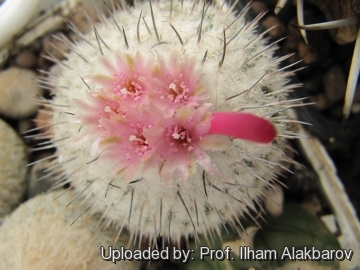
Epithelantha micromeris subs. unguispina Photo by: Prof. Ilham Alakbarov
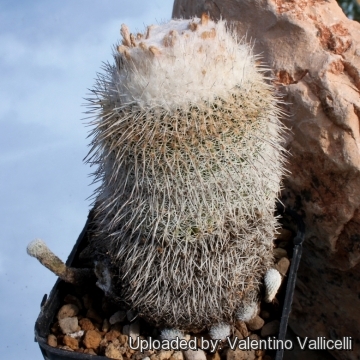
VM635 Castaños, Mexico Photo by: Valentino Vallicelli
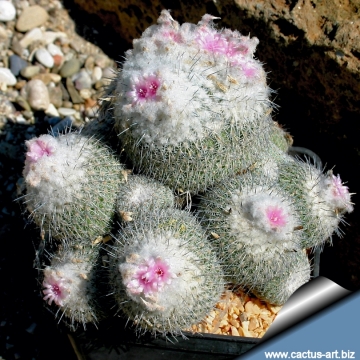
Epithelantha micromeris subs. unguispina Photo by: Cactus Art
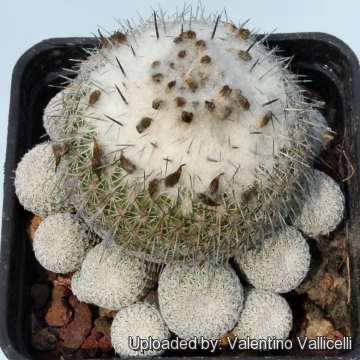
Epithelantha micromeris subs. unguispina Photo by: Valentino Vallicelli
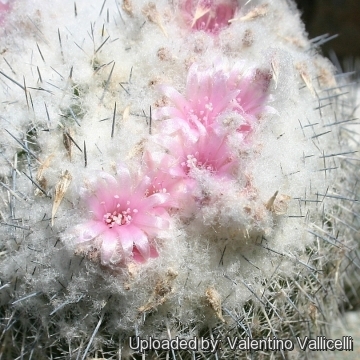
Epithelantha micromeris subs. unguispina Photo by: Valentino Vallicelli
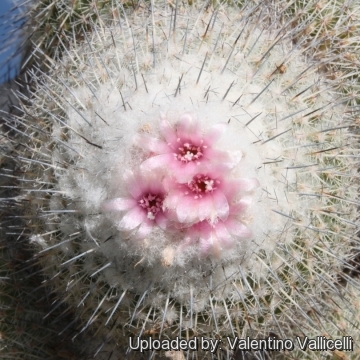
Epithelantha micromeris subs. unguispina Photo by: Valentino Vallicelli
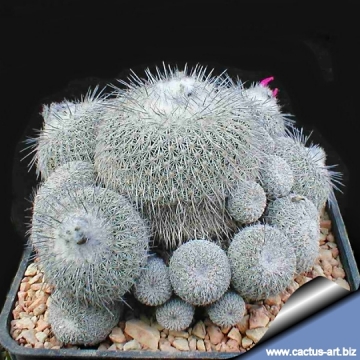
Epithelantha micromeris subs. unguispina Photo by: Cactus Art
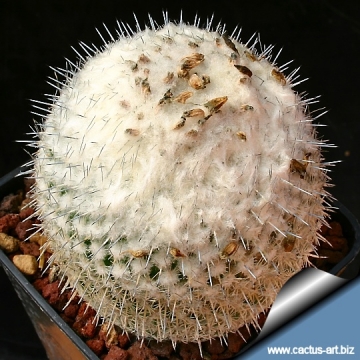
Epithelantha micromeris subs. unguispina Photo by: Cactus Art
Cultivation and Propagation: Although regarded as a choice and difficult plant, in cultivation it is relatively easy, but very slow growing. These plants need very coarse potting soil that drains well (rot prone). Waterings should be rather infrequent, to keep the plant compact and not become excessively elongated or unnatural in appearance.
Frost Tolerance: Depending on the variety, it will take -5° C (or less) (Temperature Zone: USDA 8-11)
Sun Exposure: It requires strong sun to part sun to develop good spinal growth, but some summer shade in the hottest hours of the day is beneficial. Assure a good ventilation.
Propagation: It can be reproduced both by seeds and cuttings, but it is often grafted because difficult and slow to grow on its own roots. Older specimens shoot tillers from under tubercles, so they can be grafted, which is a much easier way of propagation than sowing. Young seedlings are tiny and they need several years to reach adult size, and require careful watering.
| Your Actions | |
|---|---|
| Back to Epithelantha index | |
| Back to Cactaceae index | |
 |
Back to Cacti Encyclopedia index |
Privacy stantement - Terms and conditions - How to cite - About us - Feedback - Donate





